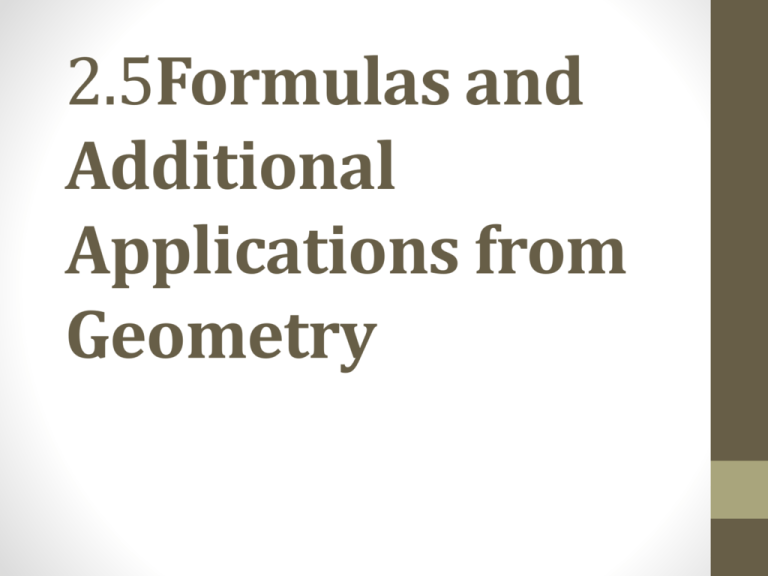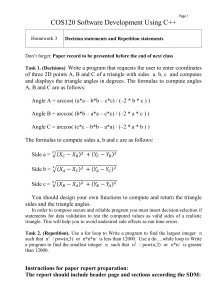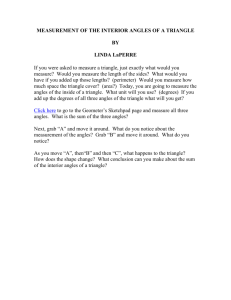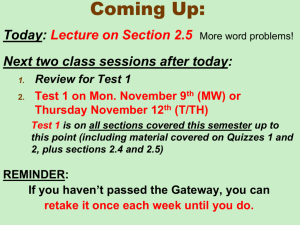2.5Formulas and Additional Applications from Geometry
advertisement

2.5Formulas and Additional Applications from Geometry Definition. Many applied problems can be solved with formulas. A formula is an equation in which variables are used to describe a relationship. For example, formulas exist for geometric figures such as squares and circles, for distance, for money earned on bank savings, and for converting English measurements to metric measurements. 9 P 4 s, A r , I prt , F C 32 5 Formulas 2 Slide 2.5-3 Objective 1 Solve a formula for one variable, given values of the other variables. Slide 2.5-4 Solve a formula for one variable, given values of the other variables. Given the values of all but one of the variables in a formula, we can find the value of the remaining variable. In Example 1, we use the idea of area. The area of a plane (two-dimensional) geometric figure is a measure of the surface covered by the figure. In the following formula A is the area of a rectangle with length L and width W. A LW Slide 2.5-5 CLASSROOM EXAMPLE 1 Using Formulas to Evaluate Variables Find the value of the remaining variable. P 2 L 2W ; Solution: P 126, W 25 126 2L 2 25 126 50 2L 50 50 76 2L 2 2 L 38 The length of the rectangle is 38. Once the values of the variables are substituted, the resulting equation is linear in one variable and is solved as in previous sections. Slide 2.5-6 Objective 2 Use a formula to solve an applied problem. Slide 2.5-7 Use a formula to solve an applied problem. It is a good idea to draw a sketch when solving an applied problem that involves a geometric. Examples 2 and 3 use the idea of perimeter. The perimeter of a plane (two-dimensional) geometric figure is the distance around the figure. For a polygon (e.g., a rectangle, square, or triangle), it is the sum of the lengths of its sides. In the following formula P is the perimeter of a rectangle with length L and width W. P 2L 2W Slide 2.5-8 CLASSROOM EXAMPLE 2 Finding the Dimensions of a Rectangular Yard A farmer has 800 m of fencing material to enclose a rectangular field. The width of the field is 50 m less than the length. Find the dimensions of the field. Solution: Let L = the length of the field, then L − 50 = the width of the field. P 2L 2W 800 2 L 2 L 50 800 100 4L 100 100 900 4L 4 4 L 225 225 50 175 The length of the field is 225 m and the width is 175 m. Slide 2.5-9 CLASSROOM EXAMPLE 3 Finding the Dimensions of a Triangle The longest side of a triangle is 1 in. longer than the medium side. The medium side is 5 in. longer than the shortest side. If the perimeter is 32 in., what are the lengths of the three sides? Solution: Let x − 5 = the length of the shortest side, then x = the length of the medium side, and x + 1 = the length of the longest side. P x x 5 x 1 32 4 3x 4 4 36 3x 3 3 x 12 12 1 13 12 5 7 The shortest side of the triangle is 7 in., the medium side is 12 in., and the longest side is 13 in. Slide 2.5-10 CLASSROOM EXAMPLE 4 Finding the Height of a Triangular Sail The area of a triangle is 120 m2. The height is 24 m. Find the length of the base of the triangle. Solution: Let b = the base of the triangle. 1 A bh 2 1 120 b 24 2 120 12b 12 12 b 10 The base of the triangle is 10 m. Slide 2.5-11 Objective 3 Solve problems involving vertical angles and straight angles. Slide 2.5-12 Solve problems involving vertical angles and straight angles. The figure below shows two intersecting lines forming angles that are numbered , , , and . Angles and lie “opposite” each other. They are called vertical angles. Another pair of vertical angles is and . In geometry, it is known that vertical angles have equal measures. Now look at angles and . When their measures are added, we get 180°, the measure of a straight angle. There are three other such pairs of angles: and , and , and and . Slide 2.5-13 CLASSROOM EXAMPLE 5 Finding Angle Measures Find the measure of each marked angle in the figure. Solution: 6x 29 x 11 180 6 20 29 149 7 x 40 40 180 40 20 11 31 7 x 140 7 7 The two angle measures are 149° and 31°. x 20 The answer is not the value of x. Remember to substitute the value of the variable into the expression given for each angle. Slide 2.5-14 Objective 4 Solve a formula for a specified variable. Slide 2.5-15 Solve a formula for a specified variable. Sometimes it is necessary to solve a number of problems that use the same formula. For example, a surveying class might need to solve the formula for the area of a rectangle, A = LW. Suppose that in each problem area (A) and the length (L) of a rectangle are given, and the width (W) must be found. Rather than solving for W each time the formula is used, it would be simpler to rewrite the formula so that it is solved for W. This process is called solving for a specified variable, or solving for a literal equation. When solving a formula for a specified variable, we treat the specified variable as if it were the ONLY variable in the equation and treat the other variables as if they were numbers. We use the same steps to solve the equation for specified variables that we use to solve equations with just one variable. Slide 2.5-16 CLASSROOM EXAMPLE 6 SolveI Solving for a Specified Variable prt for t. Solution: I prt I prt pr pr I t, pr or I t pr Slide 2.5-17 CLASSROOM EXAMPLE 7 SolveS Solving for a Specified Variable 2rh 2r 2 for h. Solution: S 2rh 2r 2 S 2r 2rh 2r 2r 2 2 2 S 2r 2 2rh 2r 2r S 2r 2 h, 2r or S 2r 2 h 2r Slide 2.5-18 CLASSROOM EXAMPLE 8 Solve A Solving for a Specified Variable p prt for t. Solution: A p p prt p A p prt pr pr A p t, pr or A p t pr Slide 2.5-19 CLASSROOM EXAMPLE 9 Solving for a Specified Variable 1 Solve A h b B for h. 2 Solution: 1 A h b B 2 1 A 2 h b B 2 2 h b B 2A b B b B 2A h, b B or 2A h b B Slide 2.5-20







